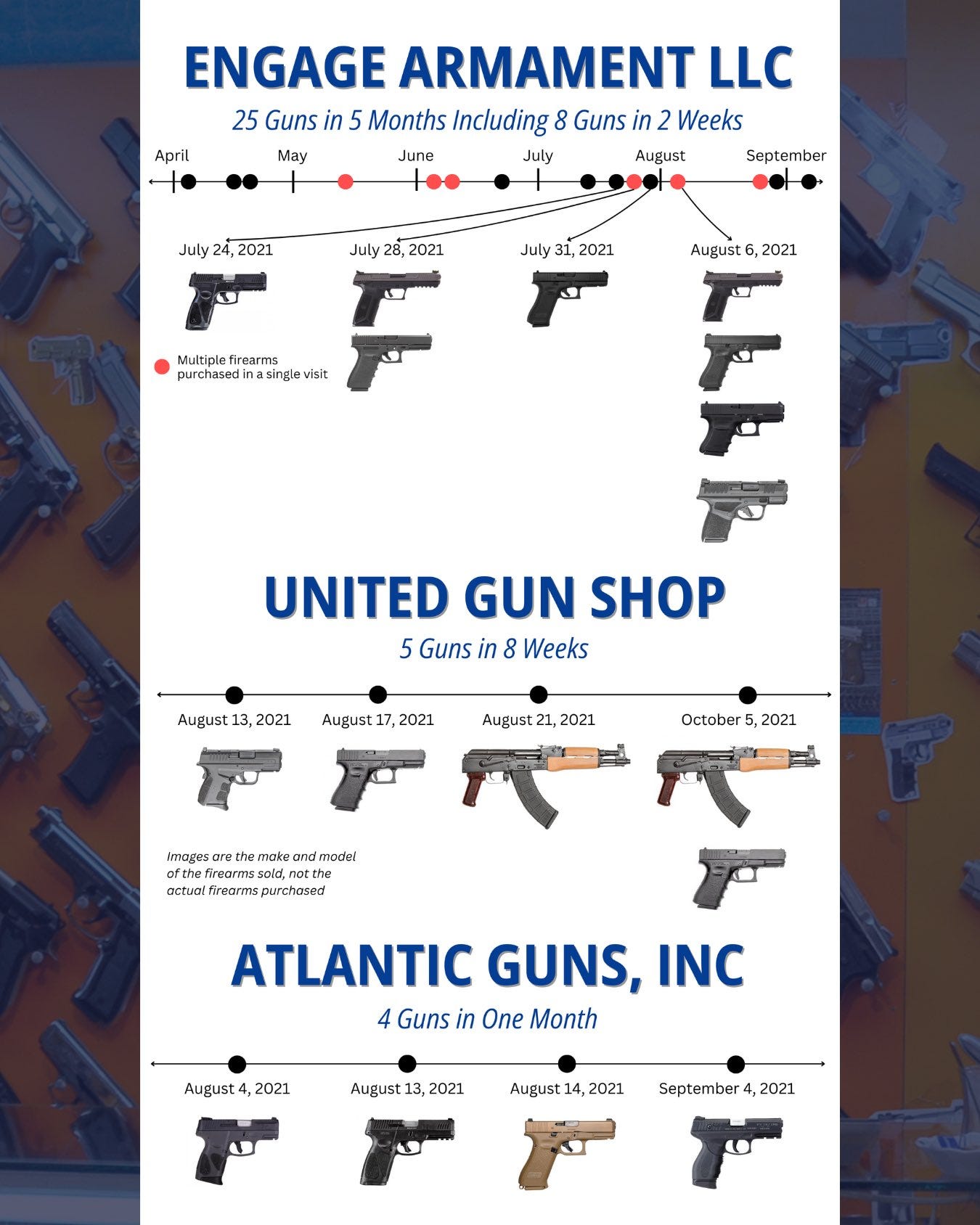OSD 313: How many guns is a lot of guns? Let’s do the math.
Back in September, the District of Columbia and the State of Maryland sued three FFLs for selling too many guns to the same person, under the theory that they should have known the guy was a straw purchaser.
Here’s an image the Attorney General of DC tweeted out as evidence:
This week, a judge dismissed the lawsuit:
Let’s do some math. The buyer in question bought 34 guns in five months. Statistically, how unusual is that?
From 2013 to 2022, Americans bought about 150 million guns. Per the same source, between 2015 and 2022 the number of gun owners rose from 55 million to 75 million. To simplify, let’s say that means that an average of 60 million gun owners bought 15 million guns per year for 10 years.
We’re going to have to make some assumptions, but let’s keep them conservative. Say the most prolific collectors in the country — the 99.99th percentile, 1 in 10,000 — own 500 guns. Say also that they take 240 months (20 years) to amass their collection. Assuming they never sell any guns, in the average month they buy 2.1 guns. But that’s just on average. If their monthly gun purchases have a standard deviation of 3 (which is pretty conservative), then in one out of twelve months, they’ll buy 11 guns.
If they do that for three months out of a five month period, they’d have 33 guns, just under the 34 that the buyer in the lawsuit bought. How often does a 1-in-12 chance come up three times in five tries? Only 0.49% of the time. But over 20 years (which has many five-month periods within it), it will happen at least once for 44% of people buying at the collector rate. At 0.01% of out 60 million gun owners, that’s a total population of 6000 people.
Those are just extreme collectors. Well below the 99.99th percentile, there are people buying at faster rates for shorter periods. People amassing, say, a 150 gun collection in five years. Or even just making a large one-time bulk purchase. And we haven’t accounted for any selling. If we did, then we’d have to assume even faster gun purchase rates for people to amass, on net, the collections that they amass.
Bottom line, 34 guns in five months is definitely an outlier, but tens of millions of gun owners is a big enough population that you’re going to find outliers. The buyer in this case was indeed a straw purchaser, which is why DC and Maryland felt the need to go after the FFLs that sold him his guns. But FFLs have to operate with the information they have at the time of a purchase. He spread his purchases across three FFLs, so each individual one had even less reason to suspect him. If they were going to deny this guy, then statistically the same evidence would lead to tens or hundreds of thousands of innocent gun owners getting denied too.
This week’s links
Tool to see how much money a nonprofit receives from other nonprofits
Partisan framing but interesting data. H/t Discord sub @_.chevron._ for the link. Check out:
Colorado Senate passes a bill restricting semi-auto rifles with detachable magazines
The revised bill would require individuals interested in purchasing a semi-automatic firearm to submit fingerprints to their local sheriff’s office for a background check. Once approved, sheriffs would issue a “firearms safety course eligibility card,” then an individual could take the required training course.
A sheriff “may deny or revoke a card if the sheriff has a reasonable belief that documented previous behavior by the applicant or cardholder makes it likely the person will present a danger to themself or others if the person holds a firearm safety course eligibility card,” the bill says.
Tbd whether it passes the House. Interesting that this is happening a week after a judge in Illinois struck down that state’s firearm owner ID card law.
About Open Source Defense
OSD Capital
We invest in civilian defense and the tech that accelerates it.
OSD podcast
In-depth interviews with outstanding founders and builders in the civilian defense industry.
The company store
Grab a t-shirt or a sticker.
Discord server
The OSD team is there along with lots of subscribers. Paid Substack subscribers can join the chat.




I remember when we decided to switch from using blue guns to real guns for our holster making. We bought a lot of handguns pretty quickly. We have our own FFL now, but we definitely bought more than 34 guns in less than 5 months through our local gun store back then.
Being as that the guns in question were regulated by the state, requiring "not disapproved" status to complete the sale, the only entity that knew in real-time that the purchases were occurring was the state of Maryland. Can't hardly blame the FFLs if the state gave them the green light to proceed with the transfer.